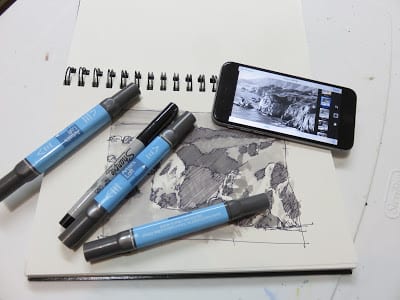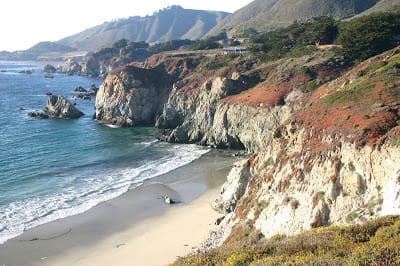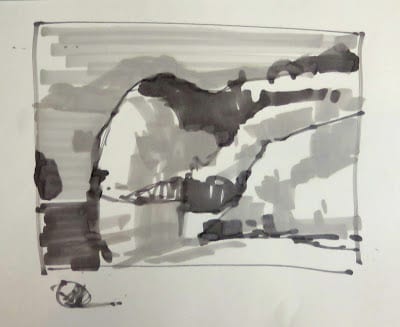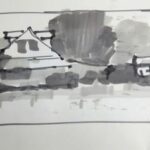“Notan” is a Japanese term referring to exploring the harmony between light and dark. Artists use Notan sketches to explore the composition elements of a scene and the relationship of major shapes. A good Notan drawing simplifies a scene into three values…dark, light and halftone. It also acts as a memory and planning tool that helps the artist focus on essential elements of a scene, draw simple shapes and record important elements should the scene change as weather and sunlight alter a scene.

I was first introduced to the importance of the Notan sketch in a workshop I took with Skip Whitcomb. Skip starts every painting session with two or three quick sketches of the scene. The process takes him about thirty minutes. As part of the workshop Skip required students to do at least three sketches before starting a painting. Since that time I have come across many artists that rely on the Notan sketch process and for years it has been my practice as well.
The advantage of a Notan sketch over a camera is the camera records everything in the scene indiscriminately leaving nothing to the imagination. That being said I have come to prefer the camera over the sketch as the smart phone increasingly takes over every aspect of our life. Using the photo app in my iPhone has reduced the time to produce a Notan to a matter minutes rather than a block of time that cuts into painting time.
I recently took the opportunity to produce a Notan sketch and a Notan photo to decide once and for all what my routine was going to be going forward. Below are my results.

South of Monterrey on the way to Big Sur is this amazing scene, painted by many. On the day of my painting the fog was rolling in and out all day constantly changing the light. The scene was so captivating it was hard to decide what to leave in and what to take out. It was the perfect time for a Notan sketch so by the time I put brush to canvas most of the major decisions would have already been made.

Like many plein air painters my “go to” format is the horizontal on a 9″ x 12″ or 12″ x 16″ panel. I also like the long, narrow horizontal format I use frequently in Texas due to the lack of mountains or anything taller than a fence post. My first inclination was the long horizontal as seen in my Notan which took about ten minutes.

Just for kicks my second sketch was a square format and my third sketch was my usual horizontal.

The whole process took longer than expected because of the fog that would come in and obscure the distant cliffs that I wanted to include in my painting so all total it took almost forty minutes to get the sketches done.
Simultaneously when the sun was just like I wanted, I took a single photo with my iPhone and as the fog destroyed my scene, I quickly opened the photo app
to look at the scene in different formats.

I first looked at the long, horizontal format, cropped it accordingly and saved the image for future reference.

Then I cropped the same photo in the more typical horizontal for a 9″ x 12″ painting. Again I saved it for later.

Then I used the halftone filter to give me a Notan photo of my scene. The whole process took less than ten minutes which is an important consideration when the goal was to produce four paintings this day.

“On the Way to Big Sur” 9″ x 12″ oi/linen
When it came time to paint, the fog became unavoidable. In the end I gave in and included it in my painting, but the Notan exercise was well worth the effort.
Below is another example of sketch versus photo Notan.
The painting.

There is something that makes me feel more “artistic” drawing Notan sketches before beginning a painting. But at the end of the day, for me at least, its all about evaluating the scene for composition and values and the iPhone provides me the quickest means to an end while also providing me a permanent record. In less than ten minutes I can produce several Notan photos with complete halftone evaluations of my scene and I think it gives me a clearer understanding before I begin to paint.






Susan Ploughe says
Everything I have read defines notan as a two value design, dark and light only, with no middle value. Regardless of the terminology, however, I am totally on board with the process of doing value sketches before painting! I am less enamored by doing them digitally because it can be too easy to merely accept the shapes in the scene as they are; I find that in the process of sketching the thumbnails, I understand the shapes and their relationships better, and I can then alter or improve them. Don’t get me wrong, though. I love the many ways technology can help us with our art!
artist says
There is an app called Value Viewer that allows you to easily create a true notan image (black and white, without greyscale). It’s very helpful to view a notan image so help evaluate the pattern of lights and darks, so important to composition. There are other settings providing various degrees of simplified lights and darks, as posterization does. I don’t know anyone who paints from those images but they are valuable for visualizing.
But regardless of technology, there is nothing as valuable as sketching first!
Lori Putnam says
Thanks for the plug. It is great for opening your mind to possibilities for sure. We are currently in the stages of updating the app to run more efficiently on the latest operating systems. Only available for iPhone and iPad.
Julie Wende says
I was browsing my local art center coop and my biggest criticism of the work of amateurs (and I consider everyone south of Michelangelo, an amateur…) is that lack, and lack of design in general with respect to the ‘magic rectangle.’
Peg L Gerrity says
Heavens, you’re good at this, Rusty!